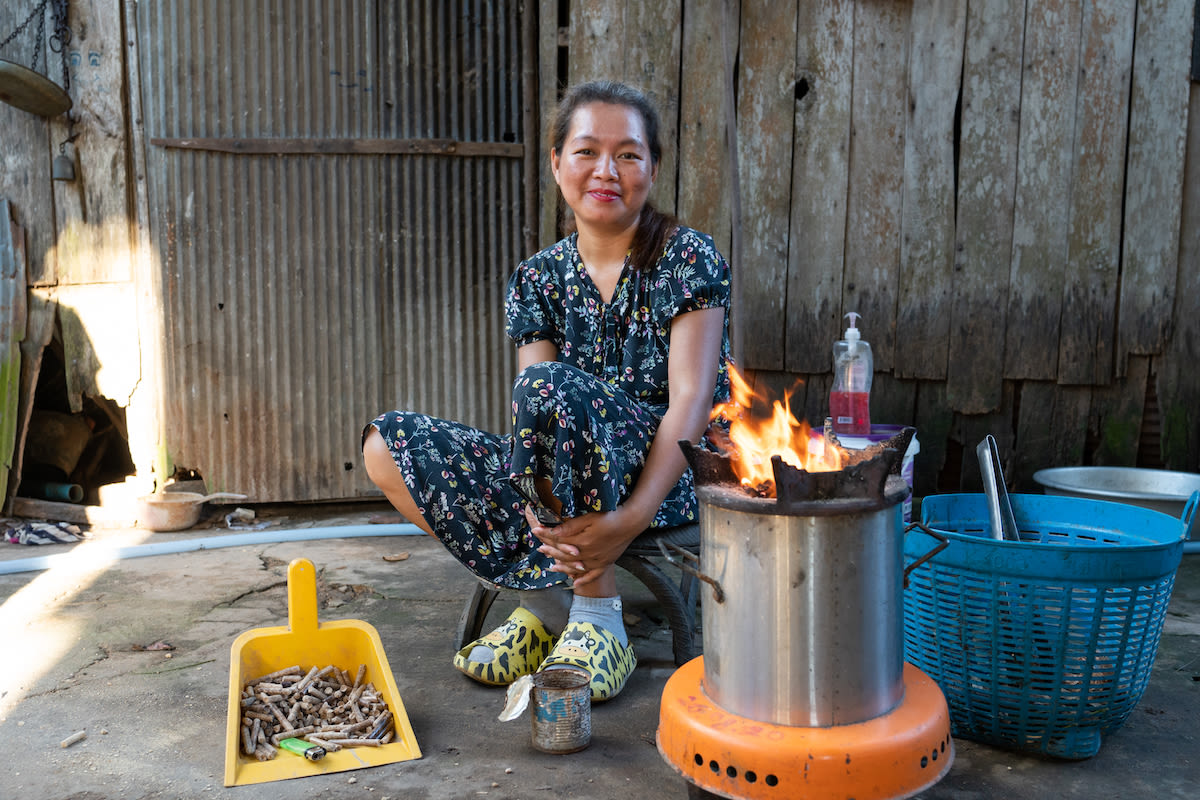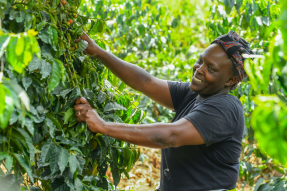The effects of climate change have already begun to take a toll, especially on people already vulnerable to instability. Communities all over the world have been severely impacted by wildfires, floods, and droughts that destroy houses and crops. The UN reports that since 2008, an average of 21.5 million people a year have been displaced by environmental disasters, and the number continues to grow.
While adapting to the reality of climate change isn’t simple, there are plenty of actions we can take as individuals and communities. We can help mitigate some of the worst repercussions of climate change by reducing greenhouse gas emissions, while also supporting the resilience of those who are most vulnerable to the shifting environment.
What we know about climate change
The main cause of climate change is human activity, primarily from the emission of greenhouse gasses from fuel and other sources of power. When released, these gasses cover the planet and insulate it like a blanket, preventing heat from dissipating into the atmosphere and causing global temperatures to rise.
Carbon dioxide and methane are the two most prevalent greenhouse gasses released in massive amounts by humans over the last hundred years. Burning fossil fuels like oil, coal, and natural gas discharges carbon dioxide into the environment, while commercial agriculture and landfill storage contribute to dangerous levels of methane.
While there is no single solution to address climate change, scientists maintain that reducing the amount of greenhouse gasses emitted by industry and individuals is essential to help lessen its worst effects.
Read more: 5 ways to actively help the Earth
What’s being done about climate change?
An increase in global warming began alarming scientists in the 1980s. While initially slow to act, as temperatures have risen and weather patterns have become more erratic, governments have come together to agree on how to reduce the human-driven causes of climate change.
In 2015, 194 world leaders signed the Paris Climate Agreement, which commits countries to reducing greenhouse gas emissions and working together to bring about a “net zero” world. “Net zero” is the term for scaling down carbon emissions to an amount of residual emissions that is so small it can be absorbed by nature and other carbon dioxide removal measures, leaving zero in the atmosphere.
The Paris Agreement dictates that in order to stave off the worst damage, humanity must reach net zero by 2050, which can only be done by cutting back on fossil fuels and employing alternative sources of energy.
How are people around the world adapting to climate change?

While everyone will be affected by climate change, it is the most vulnerable and least developed communities of the world who are already suffering its greatest effects. Millions have been displaced due to environmental disasters like flooding, drought, wildfires, and extreme heat. Many more smallholder farmers are impacted by changing weather patterns which have made it difficult to earn a sustainable livelihood from their crops.
While part of the Paris Accord dictates that wealthier countries will direct funding to help developing countries, current contributions are only 21% of the US$300 billion necessary to build resilience for these vulnerable regions, as estimated by the UN.
In spite of the challenges, there are many projects in progress to help people adapt to climate change. It’s encouraging to see these innovative examples of climate adaptation around the globe.
In the face of erratic rainfall, women in Ghana’s rural communities have diversified their crops to increase their livelihoods.
Farmers in Costa Rica’s coastal areas are using rooftop water management systems to adapt to flooding and prevent food insecurity.
A number of large-scale endeavors are underway in India, including coastal risk reduction and climate-resilient agriculture.
In Vietnam, where 60,000 homes are lost to flooding each year, coastal farmers are developing beekeeping as a climate-resilient source of income.
The city of Copenhagen, Denmark, has offset flood risks by installing road tiles that redirect rainwater to the surrounding landscape.
One of the earliest adopters of climate change adaptation, the tiny Pacific Island state of Kiribati has taken proactive steps by installing early warning systems for rising ocean levels.
What you can do about climate change at home
Even small acts can help reduce the amount of carbon and methane released into the atmosphere and steer a better course for the future.
1. Use less energy
By becoming more efficient in the use of electricity, gas, and other forms of power, we are already reducing the amount of problematic pollution released into the atmosphere. Here are a few ways to increase your home’s energy efficiency:
Turn off lights and appliances when not in use
Insulate roof and crawl spaces to stabilize inside temperatures
Install solar panels if financially feasible to reduce dependence on electricity created by fossil fuels
2. Dress smarter
Keeping up with the latest trends can have a negative impact on the environment. A recent study reports that the fashion industry is responsible for up to 10% of the total carbon dioxide emissions of the entire planet, in addition to producing large amounts of waste. Each of us can offset this by buying fewer new garments, purchasing second hand, and wearing the clothes we already own for longer.
3. Drive less
A quarter of all greenhouse gas emissions come from transportation, much of it from single drivers in individual vehicles — one car can put out up to 4.6 tons of CO2 a year! Here are some alternative ways to keep those climate change-causing materials from the atmosphere:
Carpool
Ride a bike or scooter
Use public transportation
Reduce flight travel
Consider purchasing an electric vehicle if feasible
4. Plant trees and save the forests
As humans release carbon dioxide into the atmosphere by burning fossil fuels, trees do the exact opposite: They take in CO2 and store it in their trunks, leaves, and roots; plus, they emit the oxygen that’s vital to life on earth. While scientists say that offsetting climate change isn’t as simple as planting more trees, stopping trees from being cut down can have a big impact.
5. Keep the pressure on politicians and companies
Public outcry has spurred efforts to combat climate change, but many world governments have been slow to act and corporations haven’t kept their promises to reduce pollutants and waste. Continuing to hold them accountable through online petitions, in person protests, and letter-writing campaigns can make a significant difference in future policies on the environment. It’s also important to remember we make an impact with our wallets — we wield power by directing dollars to businesses that are making sustainable choices.
With Kiva, it’s easy to take your fair share of climate action
How what you eat affects climate change
Another thing you can do about climate change is to pay attention to what you eat. It sounds surprisingly simple, but there is an opportunity with every meal, snack, grocery store trip, and restaurant order to make an impact on the environment. Here’s how:
6. Eat less red meat
Demand for beef has decimated the world’s forests, which have been cut down for grazing cattle. Cows themselves also produce methane, one of the most prevalent greenhouse gasses that cause global warming. Studies show that by replacing red meat with poultry, fish, beans, and other less-climate intensive proteins, we not only make a better choice for the environment, but also for our own health.
7. Keep food waste to a minimum
The food supply chain is a big contributor to climate change, and yet a third of all food is wasted every year, ending up in landfills. Buying only what we need and learning to cook sustainably can help conserve resources.
8. Reduce plastic use
Single-use plastic is produced from fossil fuels, and creating these plastics emits vast amounts of greenhouse gasses. Replace single use plastics with reusable ones or alternative materials.
9. Plant a garden of your own
Growing your own food can help fight climate change by reducing waste and the need to use fossil fuels to transport and shop.
How to help others face climate change

Humanity must face climate change as a collective if we are to avoid the worst scenarios of our changing planet. As well as taking actions in your own home, there are plenty of ways to support others who already need to adapt to the changing climate or who are trying to take larger actions to reduce emissions.
10. Support shifts to cleaner energy
There are 940 million citizens around the world who do not have access to electricity. About a third of the global population depends on kerosene, charcoal, or other dirty materials to cook or generate power, which not only contributes to polluting emissions but also poses tremendous health hazards. You can help by supporting global efforts to bring affordable solar-based alternatives to these communities. With Kiva loans, you can help underserved individuals invest in clean energy sources or support the growth of renewable energy companies which are helping spread access to clean energy in low income communities.
Read more: Cooking clean: The innovative energy system that’s helping the environment
11. Support sustainable agriculture
Commercial agriculture depends heavily on chemical fertilizers, pesticides, and monocropping, contributing to water pollution and nearly a third of the emissions that cause climate change. Sustainable agricultural practices worldwide use 56% less energy and create 64% less CO2 emissions than conventional farming, as well as increasing crop yields.
As well as choosing more sustainable fruits, vegetables and meats at the supermarket, you can support climate-smart loans to smallholder farmers by contributing to their loans on Kiva. With access to loans, smallholder farmers, one of the most vulnerable populations when it comes to the effects of climate change, can invest in regenerative agriculture while also producing higher yields more consistently, supporting both their livelihoods and global food security.
12. Support eco-friendly small businesses
While large corporations might be slow to change their policies and cut down on pollution, there are likely small businesses in your community that are making a difference. Look for local places that reduce supply chain costs, like farmers markets and “refilleries” that allow you to reuse bottles and packaging instead of creating more waste. You can also support mission-driven small businesses with Kiva loans which help them access the funding that they need to grow.
13. Lead the charge
One of the surest ways to make an impact as an individual is to help make others aware of the issues. Speak to friends and family about the ways they can reduce their greenhouse gas emissions. Join an organization that educates communities on the threat of climate change, or join a Kiva lending team like the Climate Pilots — a group of lenders who use “their climate knowledge to guide people through difficult times to reach their climate goals in the most impactful and equitable way.”
Can individuals really make a difference?
On a warming planet of 7.7 billion people, it’s tempting to think one person’s actions aren’t going to have much of an impact. While it’s true that the onus of reducing greenhouse gas emissions lies with industry leaders and other policymakers, cutting back on our own energy use and supporting sustainable practices can make a collective impact towards net zero emissions.
At Kiva, we see everyday how small actions can add up to a big outcomes. With the support of thousands of Kiva lenders, we have been able to fund climate-smart loans for over 700,000 people.
From funding clean cookstoves and opening access to solar power for rural communities in Africa to supporting the growth of sustainable small businesses in the U.S., small loans help people fund projects that invest in our collective future.
Learn more about Kiva's work with climate-affected communities here.













